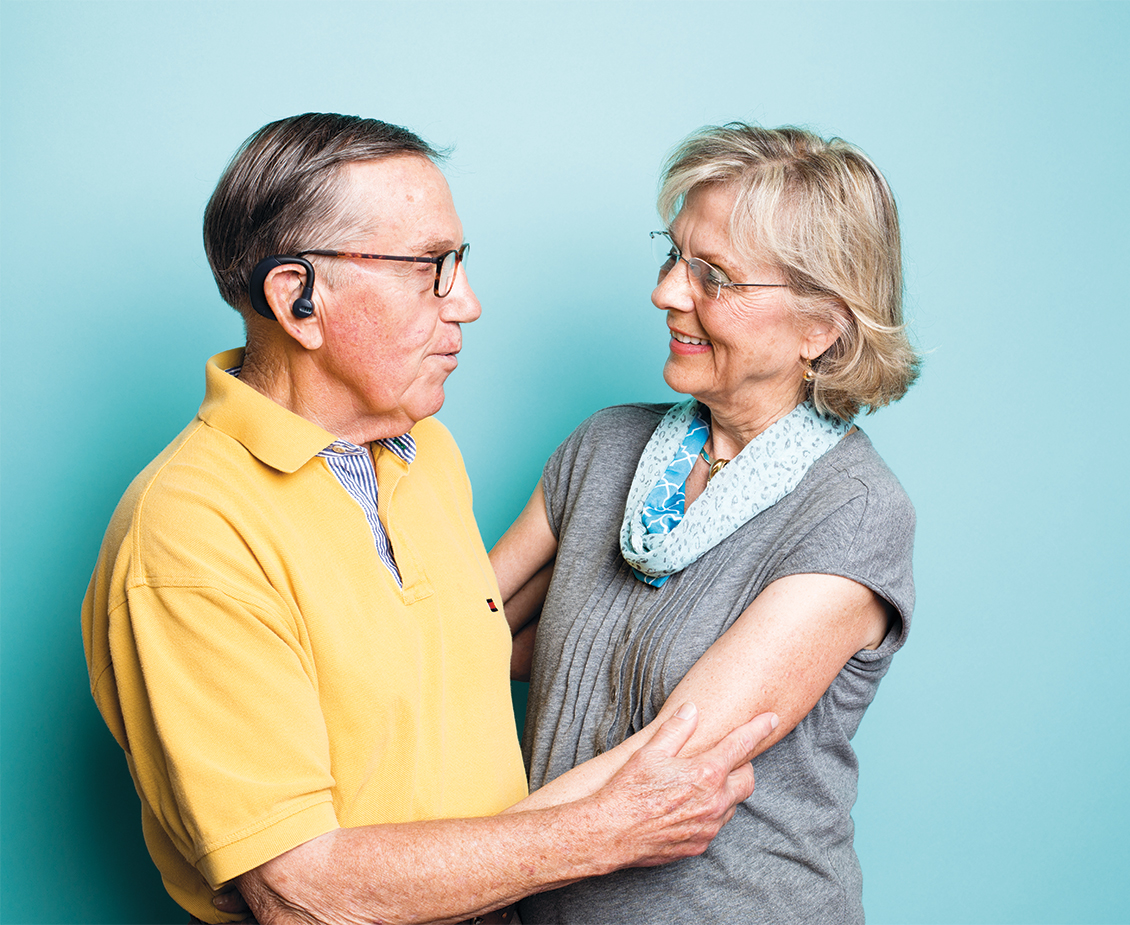Sustaining the simple joys of life
CEREBBRAL researchers work to help seniors live their best lives
Story by Amy Raley, photos by Brian Powell
While some may think late life is a time to wind down, West Lafayette seniors are demonstrating their zest for life. They are helping Purdue researchers develop interventions and devices that could improve seniors’quality of life for generations to come.
Purdue CEREBBRAL researchers work with seniors living with Parkinson’s disease to better understand and address the disease’s negative effects, as well as other declines associated with the golden years.
Through their discoveries, CEREBBRAL researchers are present in everyday activities. The ability to talk, walk, swallow and multitask may be taken for granted in youth, but these and other commonly relied-upon abilities can become difficult late in life.
CEREBBRAL: Center for Research on Brain, Behavior and Neurorehabilitation
CEREBBRAL researchers in the College of Health and Human Sciences
are determined to improve the quality of life for all people later in life.
The center has four main objectives toward that goal:
- To better understand and characterize aging and neurological diseases — mechanisms affecting brain function, physiology, communication and mobility.
- To develop optimal interventions to improve function and independence.
- To assess the impact of new interventions and devices and to make them available to the public.
- To study cognition and behavior in complex biological systems.
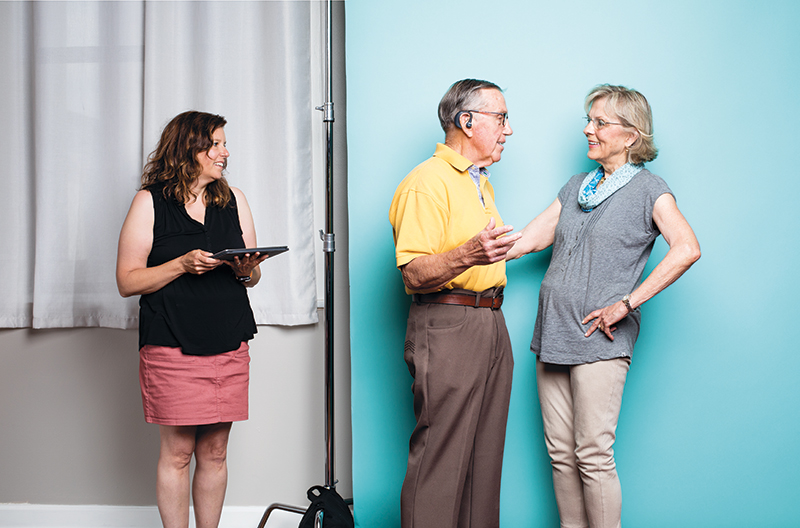
Through their discoveries, CEREBBRAL researchers are present in everyday activities.
Parkinson’s disease can lead to a loss of volume when speaking. JESSICA HUBER, co-director of CEREBBRAL, created SpeechVive (pictured below), a small device that fits into the ear and plays a low-level sound similar to white noise. The noise triggers a reflex that causes the patient to speak louder and more clearly.
‘Personalities get buried in their disease’
Jessica Huber, a CEREBBRAL co-director, got hooked on helping people with Parkinson’s disease during her first research grant years ago.
“I had this couple married for 50 years. He had Parkinson’s disease and she had hearing loss,” says Huber, who says one symptom of Parkinson’s is the loss of volume when speaking. “The husband couldn’t shout, and his wife couldn’t hear him. Now they couldn’t talk to each other.”
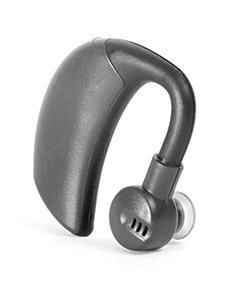
Huber, a professor of speech, language, and hearing sciences, also was motivated to help people with Parkinson’s disease whose illness was stifling their personalities. “Their personalities get buried in their disease. They might be big joke-tellers, and I’ll see in their faces that they’re joking with me because I’m used to communicating with people who have Parkinson’s disease,” she says. “But to someone who doesn’t have experience with how Parkinson’s disease affects communication, that personality gets buried.
“This was heartbreaking to me. I felt that the way I could make a big impact with my career was to pay attention to this and really take the time to figure out what works best and for whom.”
Huber’s efforts have paid off with a device she patented called SpeechVive. Available at speechvive.com, the device fits into the ear and plays a low-level sound like white noise. The noise triggers a reflex that causes the patient to speak louder and more clearly.
Called the Lombard Effect, for its discoverer Étienne Lombard, the reflex causes people to increase their vocal effort when talking in a loud environment, such as a loud restaurant. Not only does the reflex cause the speaker to talk louder, it affects speech rate and clarity. The net result is speech that’s easier to hear and comprehend.
Three clinical trials have shown SpeechVive improving speech in up to 90 percent of patients, while 75 percent saw improved loudness and 65 percent slowed their speech speed.
“Combinations of better loudness and speed created clearer speech and articulation. People go from being hard to understand to much easier to understand,” she says. “There is no other device like this on the market that’s proven to improve communication for people with Parkinson’s disease.”
Huber is now developing SpeechVive’s next iteration, which will incorporate a computer app with video. The software program will monitor SpeechVive’s effectiveness remotely while patients use it at home, allowing researchers to tweak and optimize the tool at a distance.
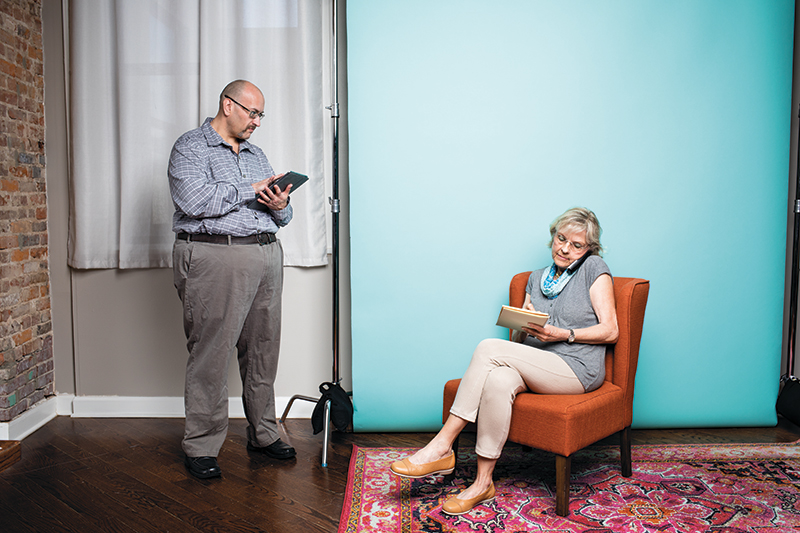
Parkinson’s-related problems may include deficits in attention and focus and handling more than one task at once — like talking on the telephone while jotting down notes. Sébastien Hélie, co-director of CEREBBRAL, is developing interventions that retrain the brain, in effect skipping disrupted neural circuitry.
Reading the brain
Huber works alongside fellow CEREBBRAL co-director Sébastien Hélie, associate
professor of psychological sciences, whose research qualifies how the Parkinson’s-induced loss of the brain chemical dopamine disrupts the brain’s circuitry. Hélie’s ultimate objective is to establish ways to overcome, or sidestep, the disrupted circuit, using various interventions that retrain the brain.
“Dopamine affects very specific brain circuits in people with Parkinson’s disease,” Hélie says. The loss of dopamine that Parkinson’s causes compromises the brain’s ability to relay messages that plan and control body movements.
“But there is more than one brain circuit that can learn any given thing, so we are trying to learn how we can teach people — or alter the way they practice things — so that we bypass the brain circuits that have been affected by the dopamine imbalance,” Hélie says. “We want to use a different circuit that might not depend on dopamine.”
Huber says she is excited to put Hélie’s research findings into practice in therapy, particularly with people she knows well who are in a Parkinson’s support group. The group meets monthly at the Westminster Village Live Well Center in West Lafayette.
Hélie and Huber plan to work with the group on Parkinson’s-related problems such as the common difficulty with movement planning and execution — switching from one task to another, handling more than one task at once, and deficits in attention and focus.
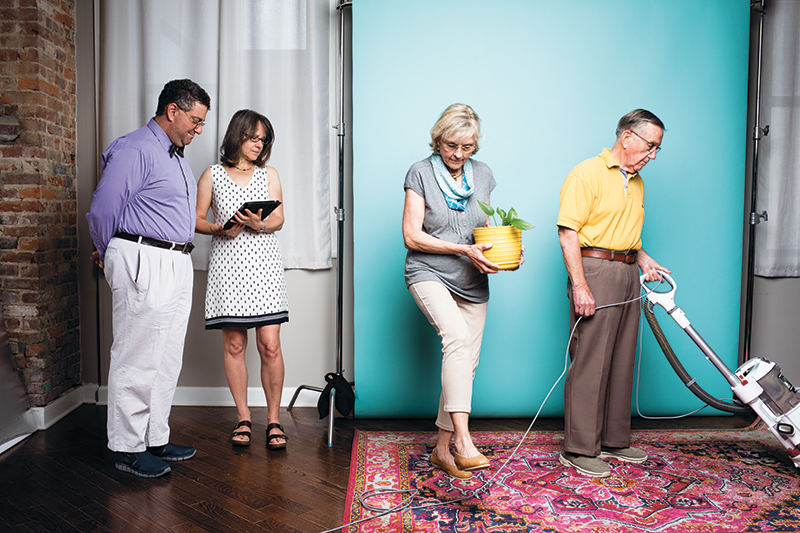
Health and Kinesiology researchers JEFFREY HADDAD and SHIRLEY RIETDYK examine problems with balance and movement in elderly people. They work to create interventions to help maintain balance and establish environmental improvements to reduce the risk for falls.
Lowering the rising rate of falling
Every 11 seconds, an older adult is treated in an emergency room for a fall, and every 19 minutes an older person dies because of a fall, according to the U.S. Centers for Disease Control and Prevention. All told, the agency says that 25 percent of all Americans who are 65 or older take a fall every year.
CEREBBRAL researchers Jeffrey Haddad and Shirley Rietdyk bring unique research perspectives and approaches to problems with balance and movement in all older people.
Haddad, associate professor of health and kinesiology, and Rietdyk, professor of health and kinesiology, work together on studies designed to learn what is causing people to fall so they can create data-driven interventions that prevent falls.
“When Jeff and I work together, he looks at combinations of tasks, like standing while putting groceries away or brushing teeth,” Rietdyk says. “I look at mobility and gait. We manipulate environmental factors such as lighting or contrast, or personal factors such as vision, and measure changes in behavior.”
Rietdyk says helpful interventions for preventing falls can range from physical therapy that trains people to maintain their balance as they stand, move or do tasks, or environmental changes such as improving the visibility of curbs by painting them with high-contrast colors.
Haddad says the two researchers also are interested in learning who is most likely to fall.
“Shirley is looking at what leads to people falling and why, and she’s finding that even young adults fall and get hurt on occasion,” Haddad says. “So, we are looking at how issues related to falls and motor coordination happen in young to middle-age people, and how that could predict falls in old age.”
Their goal is to develop methodology to evaluate who is a frequent faller and devise interventions that will reduce their falling risk.
Haddad says they’ll first conduct a survey to find people who fall frequently and those who don’t. They then will assess each participant’s balance and gait and note the differences between the two groups. The study will follow the subjects over time to determine how their falling history predicts their future risk for falling.
“Everyone who gets older has mobility issues,” Haddad says. “CEREBBRAL is looking at things like cognition and sensory factors to see how these things all work together to influence someone’s quality of life.”
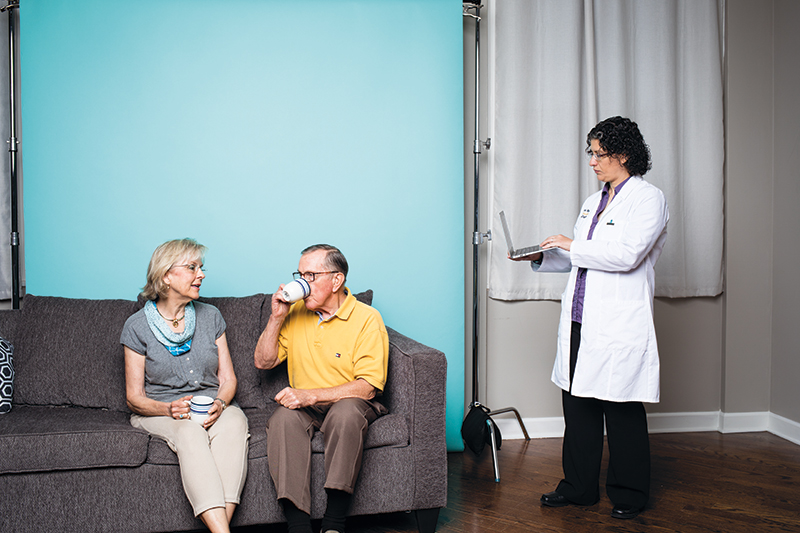
Swallowing is an act we’re rarely conscious of, but is nearly as essential to life as breathing. GEORGIA MALANDRAKI, associate professor of speech, language, and hearing sciences, works to better understand normal swallowing function and disruptions to it from aging and neurologic disorders.
An act taken for granted
Some of the other planned CEREBBRAL research applies to something we all do between 800 and 1,000 times a day.
Swallowing — an act that requires complex neural activity paired with the accurate execution of more than 35 muscle groups in the mouth, throat and esophagus — is an act we’re rarely conscious of but is nearly as essential to life as breathing.
When something interferes with the brain-muscle coordination needed for swallowing, the result can be life-threatening.
According to the American Speech-Language-Hearing Association, about one in 25 Americans experiences a swallowing problem — called dysphagia — every year. The association says dysphagia cuts across so many diseases and age groups that its true prevalence isn’t fully known and is often underestimated.
Diseases and conditions associated with swallowing problems include Parkinson’s disease, stroke, multiple sclerosis, dementia and motor neuron diseases, such as ALS — Lou Gehrig’s disease. Swallowing problems also can be among typical declines later in life.
“If swallowing problems are not treated properly, food can go down the wrong pipe and cause aspiration pneumonia,” says CEREBBRAL member Georgia Malandraki, associate professor of speech, language, and hearing sciences.
A far less recognized but still critical concern, Malandraki says, is the emotional toll. “Depression and emotional distress can come from the loss of food-related socialization if there is trouble with swallowing,” she says.
Despite its prevalence, Malandraki says dysphagia is a relatively new area of study: “There is a lot we still don’t know. We hope to better understand how swallowing function is controlled in typical development, in aging and in patients with neurologic disorders.
“We are in desperate need of more physiology treatments and interventions.”
If you look at the amount of research that goes on at all universities, it's at the level of treating or curing disease. That work is important, of course. But there is very little behavioral work to help older adults be healthier as they’re living with these diseases. The research we are doing will address the fact that people are going to get older and develop Parkinson’s or just general muscle weakness and changes in sight and hearing. We want to intervene on these issues. — Jeffrey Haddad, associate professor of health and kinesiology
Current interventions are mostly compensatory, she says. For example, people having trouble swallowing liquids, or those who choke often, are given thickened liquids. But thickened water and coffee are an unpleasant answer to the problem.
The hope is to fix the problem rather than compensate for it, Malandraki says: “We’re trying to better understand the physiology of swallowing to develop treatments that address the causes so we can improve or help recover the person’s ability to swallow.”
To that end, Malandraki’s planned CEREBBRAL research will build on previous findings that show asymmetry and inconsistencies in how people use different muscle groups and brain centers that may contribute to the decline of swallowing.
“We are now developing treatment programs so patients know how — and how much — they’re using their muscles and different organs, and how they can change that activity through biofeedback sensors we are developing in order to swallow more effectively,” she says.
Malandraki and other CEREBBRAL researchers plan to look at swallowing in coordination with other body movements and will follow people over a number of years to learn where and when the breakdown happens and what physical interdependencies might be relevant in addressing the problem.
Concerted, broad-based research
CEREBBRAL’s unique combination of researchers University-wide are determined to bring novel, multidisciplinary approaches to all challenges of old age. Members represent the fields of biology, health and kinesiology, psychology, nutrition, nursing, speech, language, hearing, and human development, as well as mechanical and biomedical engineering. Their diversity in expertise allows studies that go deeper and answer increasingly complex questions in order to give older adults their highest achievable quality of life.
“We’re not looking at a neuron in a dish,” says Huber. “We’re more interested in how you learn something about a person — whether it’s through an animal model, a computational model or human subject studies. We want to take the things we learn and couple them with the right person who sees how to apply them.”
More Life 360 Stories
Alumni
- Dean’s Message
- 2012-19 Campaign Initiatives
- HHS alumni score for professional sports teams
- HHS students and alumni giving back
- Who's Your Favorite Teacher?
- HHS celebrates Giant Leaps during Purdue's sesquicentennial
Faculty
- Dean’s Message
- Culinary experience transcends reality
- Our Teaching Best
- HHS Award-Winning Teachers
- Sustaining the simple joys of life
- Nursing project tackles overmedication at Indiana nursing homes
- Who's Your Favorite Teacher?
- Inaugural dean steps down, feeling pride in HHS’ strength, confidence in its future
- HHS celebrates Giant Leaps during Purdue's sesquicentennial
Milestones
- News
- 2012-19 Campaign Initiatives
- Inaugural dean steps down, feeling pride in HHS’ strength, confidence in its future
Students
- Culinary experience transcends reality
- International Success Stories
- HHS students and alumni giving back
- Who's Your Favorite Teacher?
- HHS celebrates Giant Leaps during Purdue's sesquicentennial

